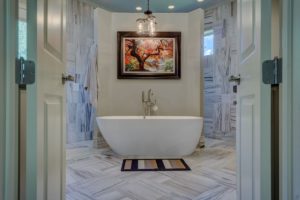The concept of home redesign has evolved significantly over the years, reflecting changes in lifestyle, technology, and design trends. Today, redesigning your home goes beyond mere aesthetics; it’s about creating spaces that are functional, sustainable, and aligned with your personal style. Modern approaches to home redesign embrace innovation, sustainability, and a blend of form and function. These are some approaches that can help transform your living space into a contemporary haven.
Open Concept Living
One of the most prevalent modern design trends is the open-concept living space. Breaking down walls and integrating different functional areas – such as the kitchen, dining, and living areas – results in a spacious and interconnected environment. Open layouts promote social interaction, enable better utilisation of natural light, and give a sense of expansiveness. To incorporate this approach, consider removing unnecessary walls, using multifunctional furniture, and maintaining a consistent colour palette to ensure a harmonious flow throughout the space.
Minimalism and Decluttering
 Modern designs tend to follow the principles of minimalism. Decluttering your home not only creates an organised and visually appealing space but also promotes mental clarity. The “less is more” philosophy emphasises quality over quantity. Invest in timeless pieces of furniture and décor, focusing on clean lines and functionality. Storage solutions that keep items out of sight when not in use contribute to the clutter-free aesthetic that defines modern interiors.
Modern designs tend to follow the principles of minimalism. Decluttering your home not only creates an organised and visually appealing space but also promotes mental clarity. The “less is more” philosophy emphasises quality over quantity. Invest in timeless pieces of furniture and décor, focusing on clean lines and functionality. Storage solutions that keep items out of sight when not in use contribute to the clutter-free aesthetic that defines modern interiors.
Smart Home Integration
With the rapid advancement of technology, integrating smart home devices has become an integral part of modern home redesign. From voice-controlled assistants and automated lighting to smart thermostats and security systems, these technologies enhance convenience, energy efficiency, and security. Designing with smart home integration in mind involves planning for discreet device placement and ensuring a seamless blend of technology with the overall design scheme.
Biophilic Design
The biophilic design acknowledges the innate human connection with nature and seeks to bring natural elements into indoor spaces. This approach can be integrated through the use of materials like wood, stone, and natural fabrics, as well as incorporating indoor plants and natural lighting. Biophilic design not only enhances aesthetics but also improves air quality and promotes a sense of well-being, making it a popular choice for modern home redesign.
Sustainable Practices
Sustainability is a key consideration in a modern home redesign. Incorporating eco-friendly materials, energy-efficient appliances, and renewable energy sources can significantly reduce a home’s environmental footprint. Reclaimed wood, recycled materials, and low-VOC paints are just a few examples of sustainable choices. Additionally, sustainable practices extend to design longevity – choosing timeless styles over fleeting trends ensures that your space remains relevant for years to come.
Flexible and Multipurpose Spaces
Modern lifestyles often demand spaces that can adapt to various needs. Creating flexible and multipurpose areas allows your home to evolve as your requirements change. A spare room can transform into a home office, a guest bedroom, or a workout space with minimal adjustments. Folding furniture, modular storage units, and convertible pieces are valuable tools in achieving this adaptable design.
Mixing Textures and Materials
The modern design embraces the art of mixing textures and materials to create dynamic and visually stimulating interiors. Combining materials like metal, glass, concrete, and textiles adds depth and character to a space. For example, rather than focusing on the cheapest options to decorate your bathroom, look for a bathroom shaving cabinet that complements the space. Vanities in a bathroom can also impact the entire feel of the space. It’s essential to strike the right balance between contrasting elements, ensuring that the design remains cohesive rather than chaotic.
Neutral Colour Palettes with Bold Accents
Neutral colour palettes are a hallmark of modern design, often featuring shades of white, beige, grey, and black. These hues provide a versatile backdrop that allows for the easy incorporation of bold accent colours. Vibrant shades like teal, mustard, or deep blue can be introduced through furniture, artwork, and accessories to add personality and visual interest to the space.
Open Shelving and Statement Storage
Storage solutions are an essential aspect of modern home redesign. Open shelving has gained popularity not only for its functionality but also for its decorative potential. Displaying curated collections or kitchen essentials on open shelves can act as a design feature. Statement storage, such as uniquely designed cabinets or sculptural furniture pieces, not only serves its purpose but also serves as a focal point.
Personalised and Unique Touches
A modern home redesign is not about replicating cookie-cutter designs from magazines. Infuse your personality into the space by incorporating unique touches that tell your story. Whether it’s vintage finds, handmade crafts, or cherished mementoes, these elements create a warm and inviting atmosphere that resonates with you and your visitors.
Whether you prefer the sleek minimalism of Scandinavian design or the cosy textures of rustic chic, modern design principles, provide a versatile framework that can be tailored to your preferences. As you embark on your home redesign journey, consider blending these approaches to craft a space that is a true reflection of your style while embracing the innovative spirit of modern design.